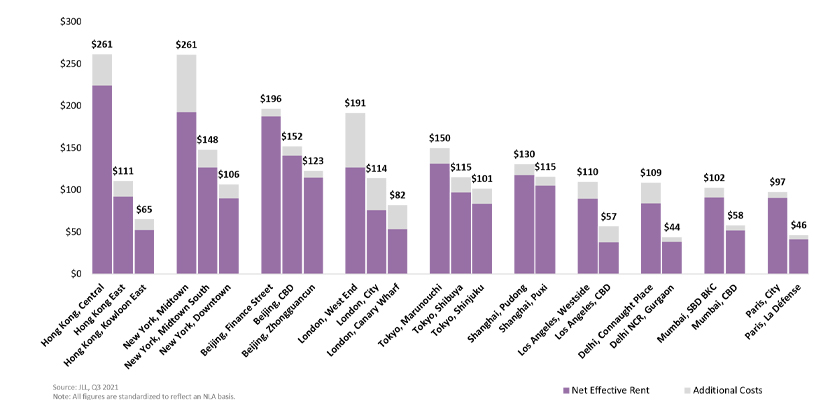Corporate tenants worldwide are seeking sustainable, healthy office space in the urban core, finds JLL

Premium office space around the world is being redefined due to the strong demand for sustainable and healthy buildings, according to global real estate and professional services firm JLL’s Premium Office Rent Tracker research report. The report, covering 127 office markets and submarkets in 112 cities, found that a high number of premium office buildings surveyed — 84% — boast an environmental sustainability certification such as LEED or BREEAM, widely used benchmarks for green buildings. In high-end markets, that number climbs to 100%, underscoring the shift toward environmental consciousness by both landlords who sought the certifications and tenants who chose to occupy green buildings.
Percentage of markets whose most premium building has…
| High-end | Mid-level | Value | All | |
| a SUSTAINABILITY certification | 100% | 89% | 76% | 84% |
| a WELLNESS certification | 8% | 16% | 12% | 13% |
Another critical feature for corporate tenants seeking premium office space? An urban core location. Despite the global impact of the pandemic on the office market, rental performance remained resilient in core central business districts across top-tier cities worldwide over the past year.
Report findings show the rental rate gap between primary and secondary or decentralized submarkets is broadening further in gateway cities such as Hong Kong, New York, Beijing and Tokyo, as corporate occupiers continue to favor city centers. This corporate interest and the steady uptick in occupancy costs drove New York’s Midtown to tie with Hong Kong’s Central as the most expensive office submarket in the world. Beijing’s Finance Street, London’s West End and Silicon Valley round out the top five.
Core and decentralized rental rate gaps substantially widened across several other cities as well. Los Angeles and Delhi, for example, experienced an increased difference of 11 ppts between primary and secondary rents from a year ago.
While urban cores struggled to remain relevant during the depths of the pandemic, due to lockdowns and a shift to remote work, many amenity-rich central business districts are now rebounding with new energy and purpose. The resilience of rents in premium buildings demonstrate the fortitude and importance of urban core locations to companies.
Jeremy Kelly, lead director, Global Cities Research at JLL
Nonetheless, affordability remains a concern in the top-tier cities, and the expanding rental gap means that secondary locations have become more affordable compared to core submarkets. On average, there is a 40%-50% discount between the primary office location and secondary or decentralized business districts across 10 major cities covered in the report.
Occupancy Cost Differentials in Key Cities (US$/s.f./year on NLA basis)

U.S. Sun Belt demand intensifies while take-up in a handful of Asian cities moderate
Other findings in the report indicate that U.S. Sun Belt demand robustly recovered following the lockdowns of 2020 compared to other office markets. Miami, Los Angeles and Houston each jumped up at least eight places in office occupancy cost rankings from the year before.
Asian cities, on the other hand, faced some volatility as Covid-19 outbreaks and accompanying government-imposed restrictions swept through the region and hindered office demand. Tokyo, Manila and Bangkok were among the Asian hubs that experienced rental rate drops compared to the previous year.
Technology, professional services firms drive rates upward
The banking and financial services industry continue to dominate demand for premium office space leasing globally. Technology firms, particularly those specializing in online platforms, come in second, accounting for demand in 17% of the most expensive markets where rates hover above $100 USD per square foot annually.
Professional and business services firms are also a major player in the premium office market, driving premium rents in 17% of the markets. Affordable markets with rates below $60 per square foot annually saw the most demand from this sector, accounting for demand in 20% of these markets.
JLL’s Premium Office Rent Tracker, 2021 research report is available to download from the firm’s website. JLL is a Fortune 500 company with operations in over 80 countries and a global workforce of more than 95,000 as of September 30, 2021. JLL is the brand name, and a registered trademark, of Jones Lang LaSalle Incorporated.
